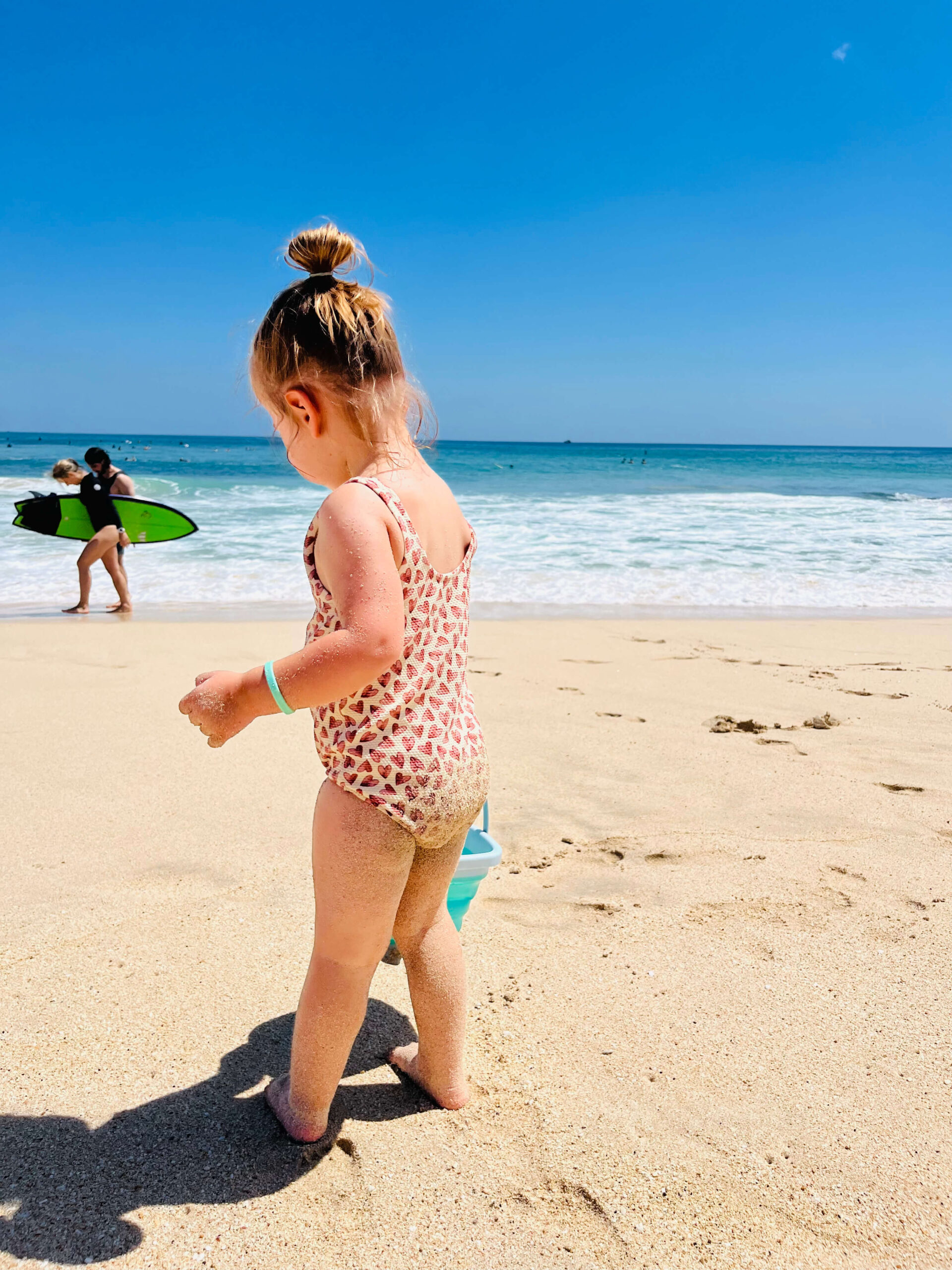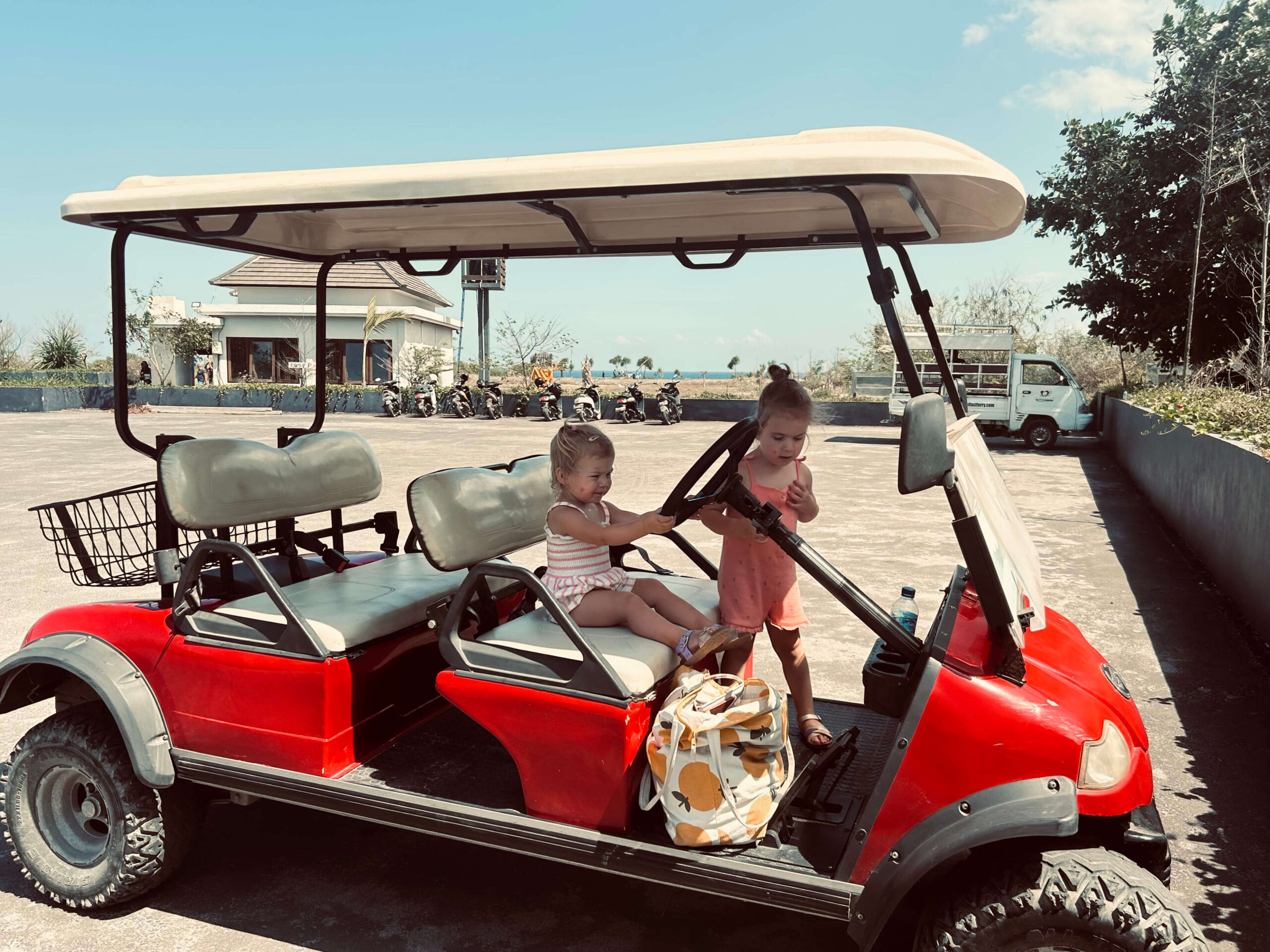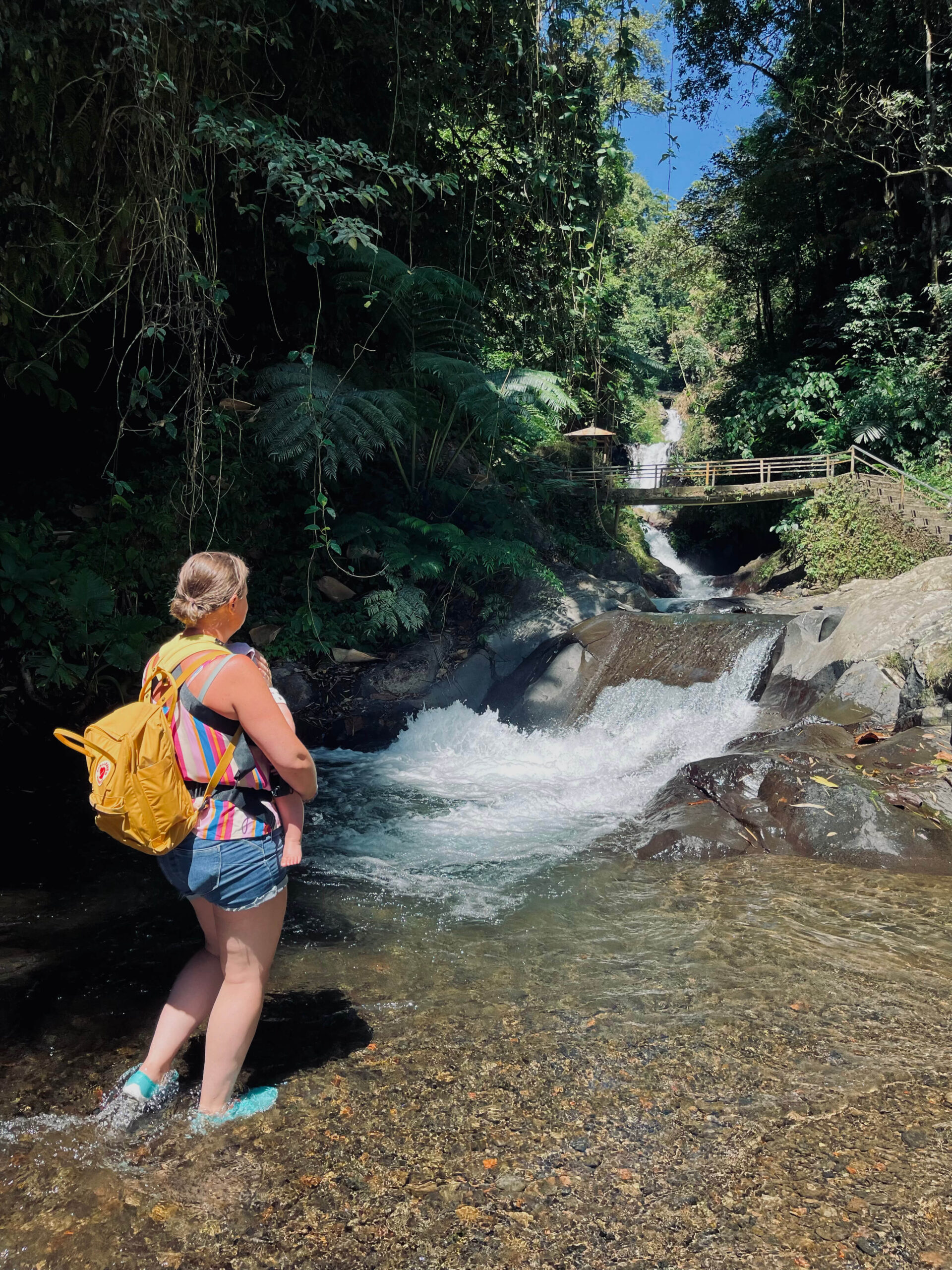
Bali with a Baby or Toddler – What You Really Need to Know
We’ve been to Bali many times before becoming parents—but once we brought our kids, it felt like a whole new kind of adventure. Our first trip as a family was when our eldest was a toddler and our youngest still a baby. We learned a lot that first time—and we’ve been back since! In this guide, we’ll share everything you need to know about visiting Bali with young children: where to stay, how to get around, what to pack, and the best things to do with little ones in tow. Make sightseeing extra fun with our free Bali Bingo – a playful game for toddlers and young children to spot animals, landmarks and tropical treats around the island. Download 👉 here!
1. Why Bali is Great for Babies and Toddlers

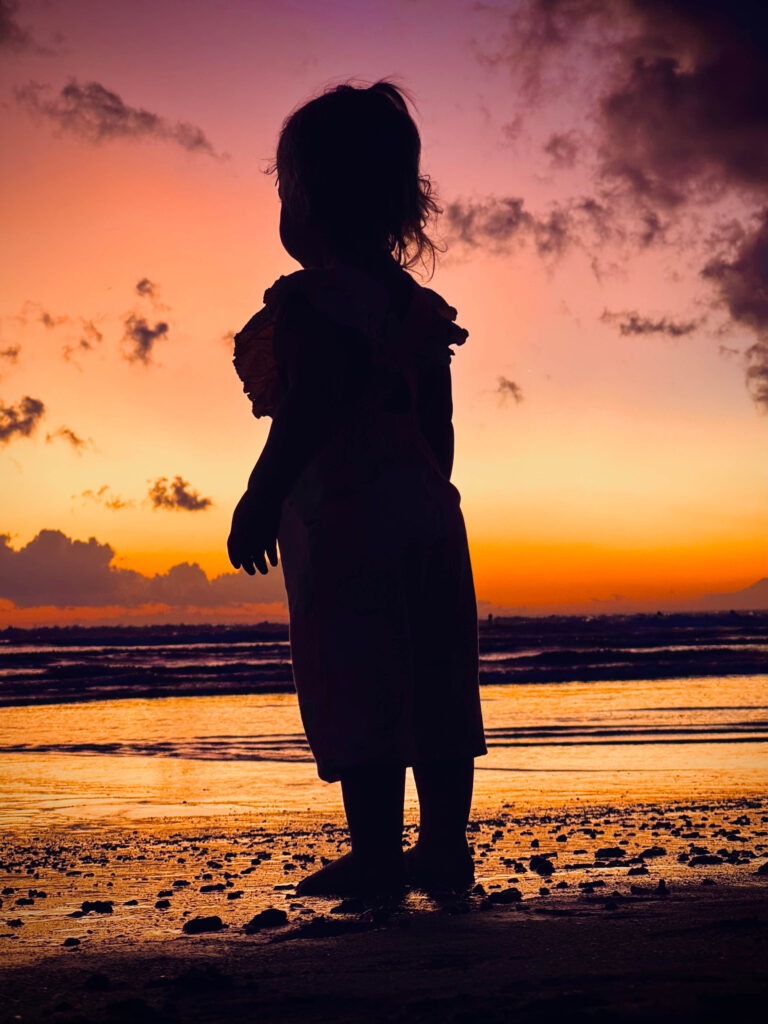
Bali is one of those rare destinations that truly works for the whole family—from the tiniest baby to adventure-loving parents. Here’s why it’s such a great choice when traveling with babies and toddlers:
- Nature everywhere: Rice paddies, jungle paths, white-sand beaches, and volcanic hills—nature is always just around the corner, and it makes every day feel like an adventure (even with a stroller in tow).
- The friendliest locals: Balinese people adore kids. Whether you’re at a restaurant, in a taxi, or walking through a village, chances are someone will be waving, smiling, or even helping to entertain your little one.
- Outdoor lifestyle: With its tropical climate and relaxed vibe, Bali makes it easy to spend most of the day outside. Your toddler can run barefoot on the beach, splash in the pool, or chase butterflies in the rice fields.
- Endless things to do: From beach days and boat trips to waterfalls, animal parks, and island hopping—there’s so much to explore that it never gets boring. You’ll find activities that excite both the kids and you as a parent.
- Great for parents too: Let’s be honest—if only the kids are having fun, the trip won’t last long. In Bali, you’ll find epic sunsets, cool beach cafés, scooter rides through the jungle, and fun little adventures like hiking to waterfalls or spotting dolphins at sunrise.
- Affordable comfort: Whether you stay in a private villa or a family-friendly guesthouse, Bali offers amazing value. You don’t need to spend a fortune to have space, comfort, and a place to call home for a few weeks.
💛 Crew Moment: One of our favorite memories? Hiking to a hidden waterfall with our toddler on our back and our baby giggling in the carrier. That’s the kind of adventure we love. But just as special are the slow evenings: watching the sunset on the beach, cold Bintang in hand, while the kids build sandcastles and chase the waves. Bali somehow makes both possible—and that’s exactly why we keep coming back.
2. When to Go – Best Time to Visit

2.1 The Rainy Season: A Risky Bet for Families
Bali’s rainy season runs from November to March. While you might get lucky with sunny mornings, heavy showers can occur and may disrupt your plans—especially with little ones in tow. To be honest, we’d recommend choosing a different destination during these months (Thailand, for example). That said, if you travel just after the rainy season (April–May), the landscape is lush and green—one of our favorite times to visit.
2.2 Peak Season and School Holidays: Busy, But Manageable
The high season—July to August—is busy but still manageable with kids. We don’t recommend traveling during Christmas and New Year, as it tends to be crowded and falls within the rainy season. If your children aren’t yet in school, try to avoid peak months. If you’re tied to school holidays, no worries—with good planning and early bookings, it can still be a great time to visit.
2.3 Weather & Comfort: What to Expect
Bali is hot and humid year-round, with average temperatures between 27–32°C (80–90°F). The humidity is higher during the wet season, which can affect sleep, skin, and overall comfort—especially for babies. Pack light clothing, bring proper sun protection, and consider accommodations with air conditioning and fans.
2.4 Visiting During Rainy Season: Just in Case
If rainy season is your only option, know that rain usually doesn’t last all day—showers often come in short, heavy bursts. However, skies remain cloudy, there’s more mud and mosquitoes, and occasional minor flooding can occur.
You’ll need to plan indoor-friendly activities and stay flexible.
💡 Crew Tip: We usually travel during the summer holidays ourselves—yep, peak season! It’s busier and pricier, but still totally doable with a bit of planning. If you’re flexible though, April, May, or September are amazing: fewer crowds, great weather, and lush landscapes after the rains
3. Where to Stay with a Baby or Toddler
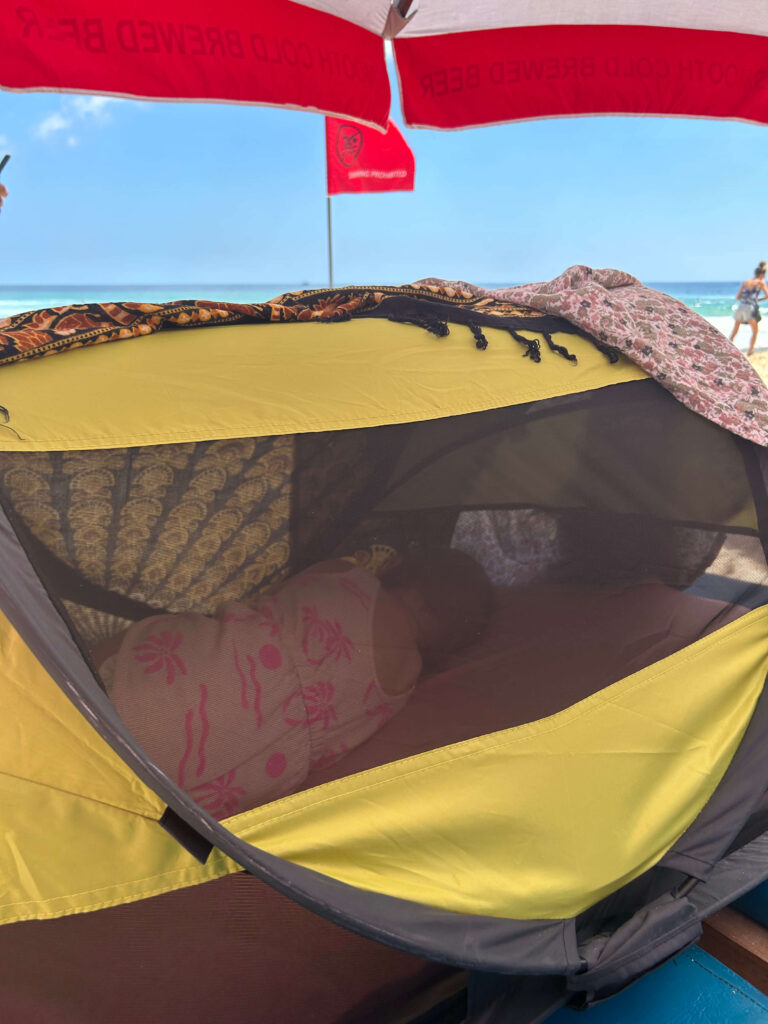

3.1 Best Areas for Families
If you’re planning your Bali family trip, we highly recommend basing yourself in one or more of these areas, which also feature in our 👉2-week Bali itinerary:
- Sanur: Calm, family-friendly beaches with shallow waters—perfect for toddlers to splash around safely. Plenty of cafes with playgrounds and easy stroller access.
- Nusa Dua: Luxury resorts, wide sandy beaches, and very safe, quiet surroundings. Ideal if you want a more relaxed and upscale vibe.
- Ubud: Cultural heart of Bali, surrounded by lush rice fields and nature. Beautiful, but stroller access can be tricky due to uneven terrain and steps.
- Canggu: Trendy and vibrant, with lots of kid-friendly cafes and playgrounds—but be warned, it’s busy and can feel hectic at times.
- Uluwatu: Known for stunning beaches and laid-back cafes. Less crowded than Canggu and great for a quieter family vibe.
- Lovina: Located in the north of Bali, a peaceful and adventurous area with calm beaches, dolphin watching, and hot springs. Perfect if you want to explore a different side of Bali.
- Nusa Islands (Lembongan, Ceningan, Penida): Great for staying a few days and enjoying a relaxed island atmosphere with beautiful beaches and snorkeling.
3.2 Accommodation Tips
We always choose accommodation with a swimming pool close enough to the room so we can relax while the baby naps nearby. Luckily, Bali offers this option across almost all budgets—from homestays to private villas. Even villas are often surprisingly affordable compared to other destinations. Don’t forget to request a baby crib and high chair when booking—they usually have these available. Air conditioning is a must-have for comfortable sleeping and keeping babies cool in the tropical heat.
There are also large all-inclusive resorts with huge pools and many facilities, but that’s not really our style of traveling with kids—still, they can be a good option if you want everything in one place.
💡 Crew Tip: We travel with a lightweight Dutch invention called the Deryan travel tent – perfect for naps at the beach or when there’s no baby bed available. (It folds up super small!)
3.3 Staying Longer vs Shorter Stays
How long to stay per location depends on your travel style. We usually spend about 3 to 4 days per spot—this gives you enough time to settle in, enjoy the area without rushing, and keep things fresh for the kids. Of course, everyone can decide what works best for their family.
💛 Crew Moment: For us, Nusa Lembongan has always been a little paradise—first as a couple without kids, and now as a family. We love its beautiful beaches and peaceful nature, plus the chance to see manta rays and dolphins up close. While one of us enjoys diving, the other spends quality time with the kids exploring and having fun. It’s a special place where both parents and little ones feel at home.
4. Getting Around Bali with a Baby or Toddler
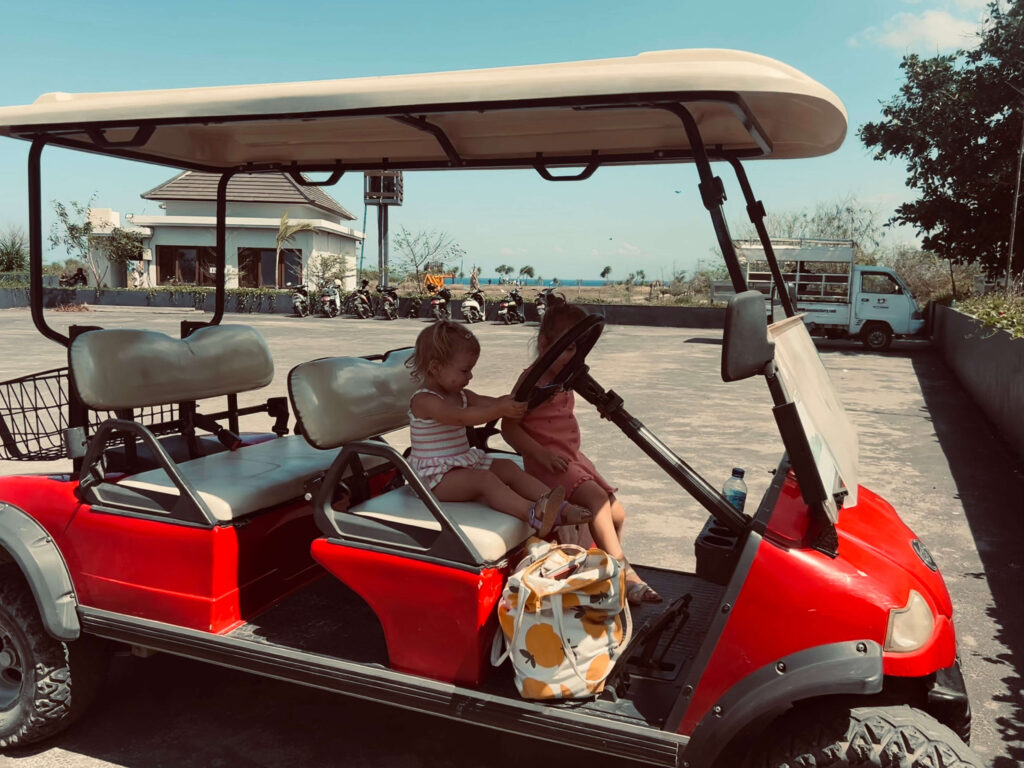
4.1 Using Grab and Drivers
We always use the Grab app for taxis and rides. It’s easy to use, you know the price upfront, and it’s available almost everywhere in Bali. For short trips, Grab is perfect. For longer distances or day tours, we recommend hiring a private driver. This way, you can stop whenever you want and explore at your own pace.
💡 Crew Tip: If you have a long drive planned (for example, from Uluwatu to Lovina), consider turning it into a mini tour by making stops along the way — like visiting a waterfall or the rice terraces at Jatiluwih. This breaks up the journey and lets you enjoy some beautiful sights too.
4.2 Car Seats & Safety
Car seats are rare in Bali but can sometimes be arranged in advance. We don’t recommend bringing your own from home — it’s bulky and impractical for traveling. If a car seat isn’t available, it’s common to hold your child on your lap and ask the driver to drive carefully. It’s not ideal, but this is how many families (including us) get around.
4.3 Scooters – Our Opinion
Scooters are everywhere in Bali, but we personally don’t find them safe for babies or toddlers. If you do consider using one, make sure your insurance covers it and think twice about the risks involved. It’s definitely not our preferred mode of transport with little ones.
4.4 Strollers and Carriers
Strollers are useful in some areas (like Sanur, Nusa Dua, and some parts of Ubud), but many roads are uneven or don’t have sidewalks. We always bring a light travel stroller for naps and downtime, and a baby carrier for more flexibility during walks and day trips.
4.5 Taking a Boat to Nusa Lembongan (or Other Islands)
Planning a visit to Nusa Lembongan or other nearby islands? You’ll need to take a fast boat from Sanur or Padang Bai. The crossing is short, but the sea can get rough depending on weather conditions. Read reviews carefully and choose a reliable boat operator.We personally prefer Ekajaya, which felt professional and reliable.
💛 Crew Moment: On our crossing to Lembongan, our daughter got seasick — not fun 😅. Since then, we always carry motion sickness tablets for kids, and we keep a plastic bag in our daypack just in case. A towel or extra clothes can also come in handy. Better safe than sorry!
5. Baby & Toddler Essentials in Bali

5.1 Diapers and Wipes
We don’t recommend bringing your own brand of diapers or wipes because Bali has plenty of options. Larger supermarkets like Pepito, Coco, and Hardy’s stock a variety of diaper brands and sizes, and we’ve always been able to find what we needed without issues. This makes traveling lighter and easier.
5.2 Swim Diapers
Swim diapers are very rarely available in Bali, so we always bring these from home to avoid last-minute hassle at the pool or beach.
5.3 Baby Food and Formula
Formula is generally available in larger supermarkets and pharmacies in popular areas like Sanur, Ubud, and Canggu, though the selection can be somewhat limited. If your baby needs a special type of formula, it’s best to bring it with you just in case. Similarly, toddler food—such as jarred purees or squeeze pouches (often called “baby food pouches”)—can be found in bigger supermarkets, but the variety is usually quite limited. If you’re staying in a place with a kitchen, you can also prepare fresh meals yourself using local ingredients and fresh fruit, which is plentiful and affordable. For picky eaters, bringing some familiar snacks or purees is often a good idea.
Many restaurants catering to families offer kids’ menus with simple toddler-friendly options like small portions of pasta, rice with vegetables, or grilled chicken.
💡 Crew Tip: You can often ask restaurants to prepare a simple, toddler-friendly meal — most places are happy to make plain rice, grilled chicken, or boiled veggies.
5.4 Additional Essentials
UV-protective clothing and a wide-brimmed sunhat are highly recommended to protect your little one from the strong Bali sun. Also, bring your favorite small toys and comfort items to keep your baby entertained and comfortable while on the move.
💡 Crew Tip: Always have a small travel first-aid kit with basics like antiseptic wipes, thermometer, and any medication your child might need. It’s better to be prepared, especially in more remote areas.
6. Health & Safety Essentials
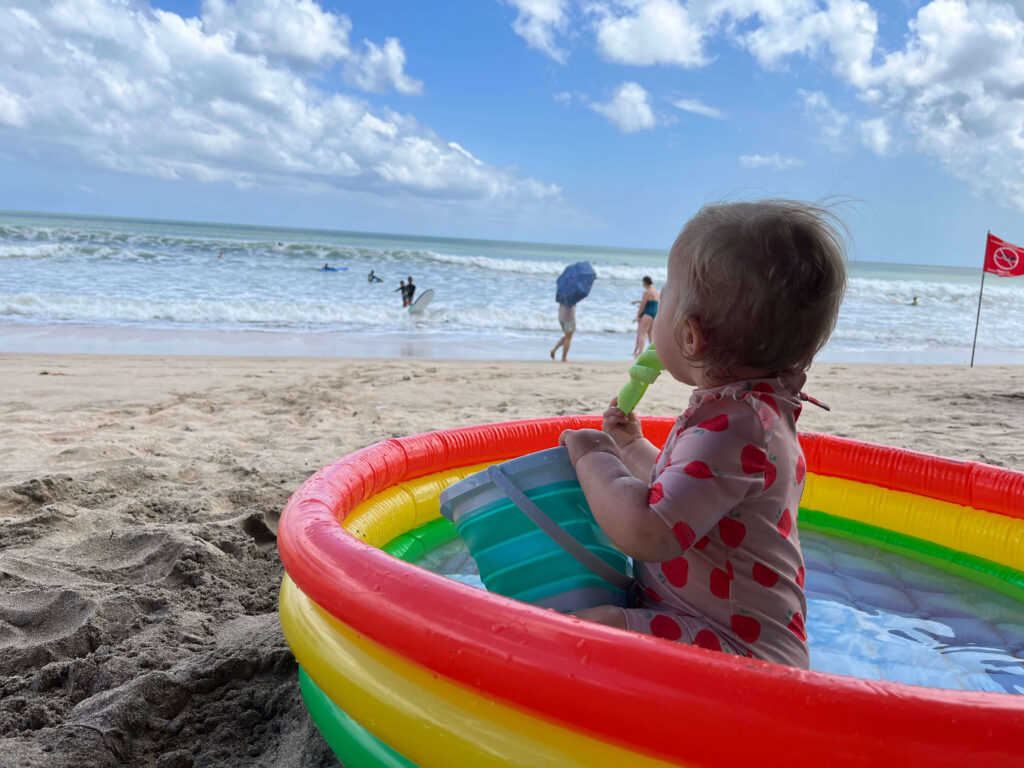
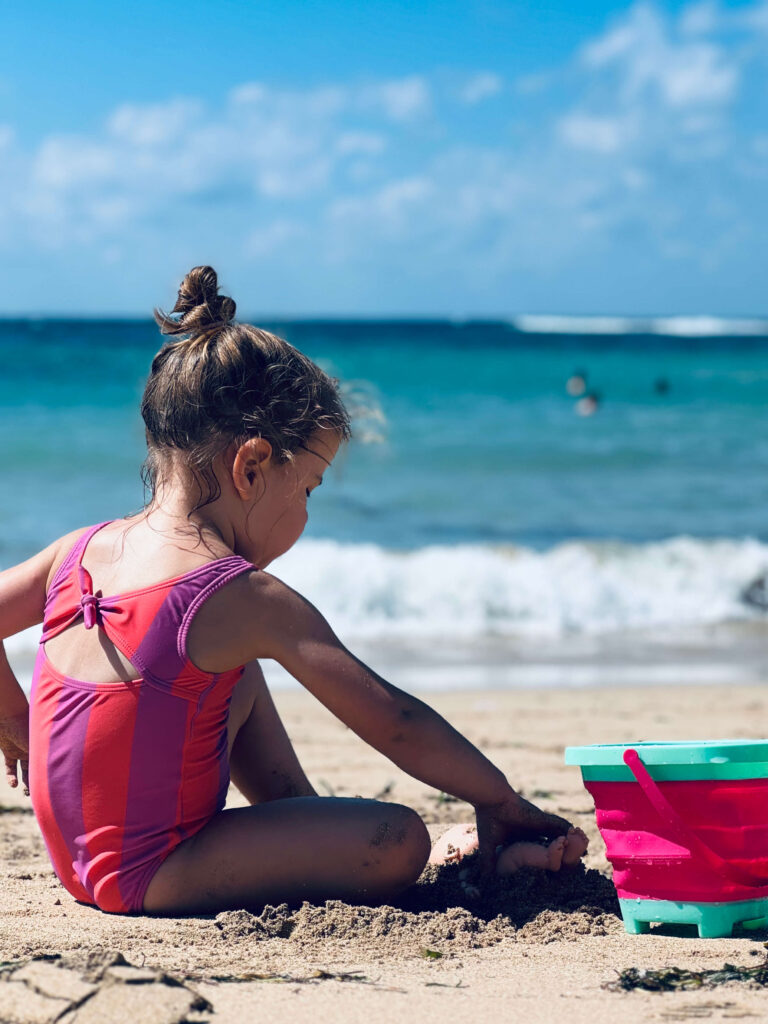
Keeping your family safe and healthy while traveling is always a priority — and Bali is no exception. The good news is that Bali is quite used to receiving families, and many services are well adapted for travelers with kids. Here are a few key things to keep in mind before and during your trip.
6.1 Vaccinations & medical prep
It’s best to check with your healthcare provider or travel clinic well in advance of your trip to Bali. Depending on your situation and travel plans, vaccinations might be recommended. It’s also smart to bring a small medical kit, including a fever reducer like paracetamol or ibuprofen for kids, and some plasters and antiseptic cream. That way, you’ll be ready for small bumps or fevers.
6.2 Pharmacies
Pharmacies (apotek in Indonesian) are easy to find in most tourist areas, and you’ll be able to get many common medications without much hassle. That said, if your child needs a specific medicine or brand, it’s best to bring enough from home.
6.3 Sun protection
The sun in Bali can be intense — even when it’s cloudy. Make sure to use plenty of sunscreen, wear hats and sunglasses, and avoid being out in the strongest midday sun. You can easily find sunscreen on the island, but it’s often more expensive than at home.
6.4 Food & water safety
Stick to bottled or filtered water for drinking and brushing teeth. Be cautious with ice cubes and raw vegetables, as these may have been washed in tap water. We usually avoid raw salads just to be on the safe side. Peelable fruits are a safer bet when you’re unsure.
In restaurants, you’ll often find a dedicated kids’ menu — but even if not, most places are happy to make a simple dish for your toddler, like plain rice, grilled chicken, or boiled veggies. We’ve had good experiences just asking for something mild and easy, even in smaller warungs. Bali’s food scene is generally very accommodating to little eaters.
6.5 Road safety
If you’re planning to rent a scooter or car, know that traffic in Bali can be chaotic. Roads and sidewalks are not always well-maintained — sometimes there are unexpected holes or missing pavement. Always double-check where your kids walk or play, especially near roads or in unfamiliar areas.
6.6 Water safety
The ocean around Bali can be strong, with changing tides and currents. Even at family-friendly beaches, it’s important to keep an eye on your kids at all times. We always bring a small inflatable pool (or buy one locally), so our little ones can safely splash around even when the ocean waves are too strong. Some pools don’t have fences, so always stay close and alert when children are swimming.
6.7 Mosquito protection
Bali is a tropical destination, so mosquitoes are a fact of life — especially around sunset and in jungle or rice field areas. Protect your kids (and yourself!) with mosquito repellent that contains DEET or another child-safe ingredient. Long sleeves and pants in the evening also help. Some families also bring mosquito patches or nets for extra peace of mind.
💡 Crew Tip: We’ve had great results using an Indonesian baby product called My Baby Minyak Telon. It’s a traditional aromatic oil that many locals use on babies, and it seemed to help keep mosquitoes away from our kids during our stay.
7. Best Things to Do with a Baby or Toddler in Bali
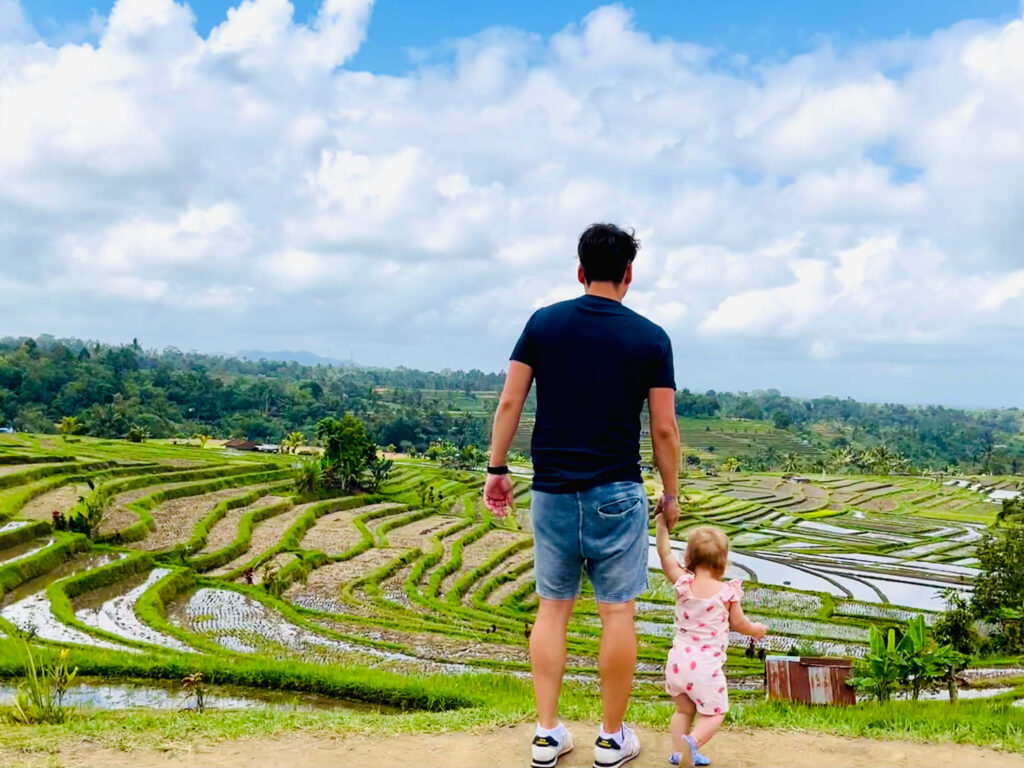
There’s so much to explore in Bali – even with a baby on your hip or a toddler in tow! From sandy beach days to animal encounters and family-friendly dining spots, the island is full of fun (and surprisingly doable!) activities for little ones.
We’ve written a whole blog with our Top 10 Things to Do in Bali with Kids – perfect if you’re planning family-friendly outings with young children. In that post, you’ll find everything from the best water park to a snorkel trip with manta rays and relaxed beach dinners with a playground.
👉 Check out our Top 10 Things to Do in Bali with Kids blog post
8. What to Pack for Bali with a Baby or Toddler


👜 Baby & Toddler Travel Essentials
- Lightweight stroller or baby carrier – Bali’s streets and sidewalks can be uneven, so a baby carrier is often more practical, especially for temple visits or short walks.
- Swim diapers – Ideal for beach and pool time. These are quite hard to find in Bali if you run out.
- UV-protective swimwear and sun hat – The sun can be intense, so cover up with high-protection clothing and a wide-brimmed hat.
- Plenty of sunscreen – Baby-friendly SPF is available in Bali, but it’s often pricier and sometimes not as gentle or familiar as what you’re used to.
- A few familiar snacks – Great for picky eaters. While toddler snacks are available in Bali, they might differ from your child’s favorites.
- Baby cutlery and a sippy cup – Super useful when eating out or snacking on the go.
- Compact changing mat – Not all restaurants or public places have proper changing facilities.
- Watershoes – Very handy for beaches with coral or slippery pools.
🧴 Toiletries & Health Items
- Diapers and wipes – Widely available in supermarkets and pharmacies, but bring a small stash to start with.
- Basic first-aid kit – Include baby-safe fever reducer, insect repellent (with DEET or a baby-safe alternative), antiseptic cream, and a few plasters.
- Hand sanitizer & tissues – A must-have for on-the-go cleanups or less-than-ideal restrooms.
- Mosquito repellent – Essential during early mornings and evenings, especially in nature-heavy areas.
👕 Clothes & Sleep
- Light cotton clothes – Bali’s climate is hot and humid, so airy, breathable clothes are best.
- Something warm for the plane or indoor air-conditioned spaces – Planes, malls, and even some restaurants can be surprisingly cold due to strong air conditioning.
- Light sleepwear – Most accommodations have air conditioning, so choose sleepwear that’s breathable and comfortable.
🧸 Comfort & Entertainment
- Comfort item – A favorite blanket, stuffed toy, or sleep sack can go a long way in helping your child feel at ease in new environments.
- A few small toys or books – Ideal for long flights, restaurant dinners, or downtime at your accommodation.
- Baby monitor – Handy if you’re staying in a villa or separate-room accommodation and want to relax nearby while your child naps or sleeps.
- Our Bali Bingo Printable – a playful game for toddlers and young children to spot animals, landmarks and tropical treats around the island. Download 👉 here!
💡 Crew Tip: Tip: We’re working on a full, printable Bali packing list for families — coming soon!
9. Final Crew Tips

Before you take off, here are a few final tips from our own experience traveling Bali with little ones — the kind of stuff we wish someone had told us:
- Take it slow, especially in the beginning. The first few days are all about adjusting — to the heat, the time zone, and the new rhythm. Plan lightly at the start and give everyone a chance to settle in.
- Don’t overplan. Some of our kids’ favorite days were spent entirely at our villa — swimming, ordering food, and just playing. You don’t need an outing every day for the trip to be special.
- Always carry cash. Not all places accept cards, and ATMs aren’t always reliable, especially in remote areas.
- Wet wipes are lifesavers. Keep them in every bag — trust us.
- Smile and connect. Balinese people absolutely adore kids. A little friendliness opens doors and hearts, even in chaotic moments.
That’s a Wrap!
We hope this guide helps you feel more confident and excited about traveling to Bali with your baby or toddler. With a bit of planning (and the right mindset), Bali can be a magical destination for the whole family — full of new adventures, playful moments, and lots of beach time.
Looking for more inspiration? Don’t miss our related family travel blogs:
- 👉 Our 2-week Bali itinerary with kids
- 👉 Top 10 things to do in Bali with kids
- 👉 Flying with a baby – our top tips
We’re sharing even more family travel tips and real-life adventures over on Pinterest and Instagram — follow us there for daily inspiration and behind-the-scenes moments:
This post is also available in:
Nederlands
